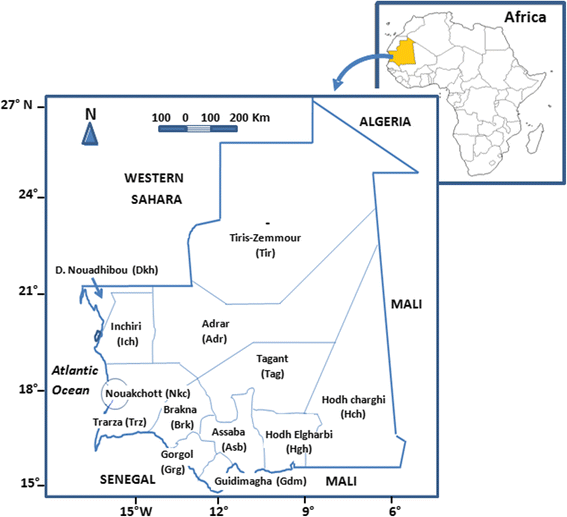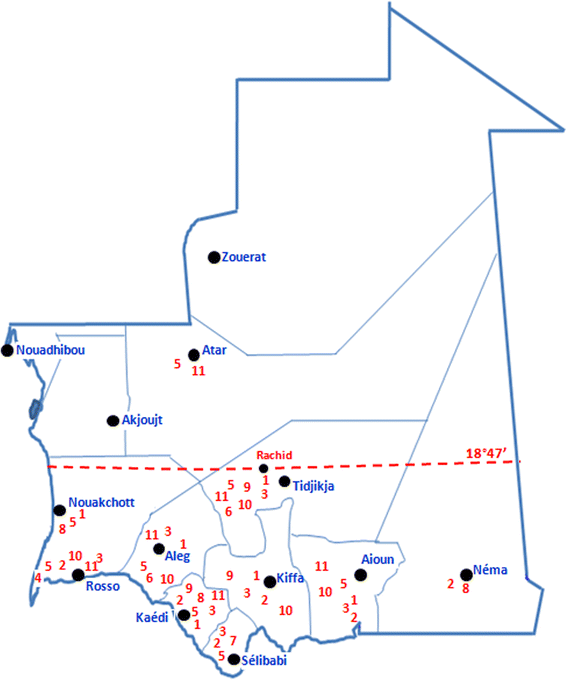Mosquitoes (Diptera: Culicidae) in Mauritania: a review of their biodiversity, distribution and medical importance
- PMID: 28103955
- PMCID: PMC5248481
- DOI: 10.1186/s13071-017-1978-y
Mosquitoes (Diptera: Culicidae) in Mauritania: a review of their biodiversity, distribution and medical importance
Abstract
Although mosquitoes (Diptera: Culicidae) are important disease vectors, information on their biodiversity in Mauritania is scarce and very dispersed in the literature. Data from the scientific literature gathered in the country from 1948 to 2016 were collected and analyzed. Overall 51 culicid species comprising 17 Anopheles spp., 14 Aedes spp., 18 Culex spp. and two Mansonia spp. have been described in Mauritania among which Anopheles arabiensis, Aedes vexans, Culex poicilipes and Culex antennatus are of epidemiological significance. Anopheles arabiensis is widely distributed throughout the country and its geographic distribution has increased northwards in recent years, shifting its northern limit form 17°32'N in the 1960s to 18°47'N today. Its presence in the central region of Tagant highlights the great ecological plasticity of the species. Conversely, the distribution of Anopheles gambiae (s.s.) and Anopheles melas has shrunk compared to that of the 1960s. Anopheles rhodesiensis and An. d'thali are mainly confined in the mountainous areas (alt. 200-700 m), whereas Anopheles pharoensis is widely distributed in the Senegal River basin. Culex poicilipes and Cx. antenattus were naturally found infected with Rift valley fever virus in central and northern Mauritania following the Rift valley outbreaks of 1998 and 2012. Recently, Ae. aegypti emerged in Nouakchott and is probably responsible for dengue fever episodes of 2015. This paper provides a concise and up-to-date overview of the existing literature on mosquito species known to occur in Mauritania and highlights areas where future studies should fill a gap in knowledge about vector biodiversity. It aims to help ongoing and future research on mosquitoes particularly in the field of medical entomology to inform evidence-based decision-making for vector control and management strategies.
Keywords: Biodiversity; Culicidae; Dengue; Malaria; Mauritania; Mosquitoes; Rift Valley fever; Vector.
Figures



References
-
- Schaffner F, Angel G, Geoffroy B, Hervy JP, Rhaeim A. The mosquitoes of Europe/Les moustiques d’Europe [computer program]. Montpellier: IRD editions; 2001.
-
- Becker N, Petric D, Zgomba M, Boase C, Madon M, Dahl C, et al. Mosquitoes and their control. London: Springer; 2010. p. 577.
-
- Fontenille D, Traoré-Lamizana M, Zeller H, Mondo M, Diallo M, Digoutte JP. Rift Valley fever in western Africa: isolations from Aedes mosquitoes during an interepizootic period. Am J Trop Med Hyg. 1995;52:403–4. - PubMed
-
- World Health Organization. A global brief on vector-borne diseases [WHO/DCO/WHD/2014.1]. Geneva; 2014.
-
- Wilkerson RC, Linton Y-M, Fonseca DM, Schultz TR, Price DC, Strickman DA. Making mosquito taxonomy useful: a stable classification of tribe Aedini that balances utility with current knowledge of evolutionary relationships. PLoS One. 2015;10:e0133602. doi: 10.1371/journal.pone.0133602. - DOI - PMC - PubMed
Publication types
MeSH terms
LinkOut - more resources
Full Text Sources
Other Literature Sources
Medical
Miscellaneous

